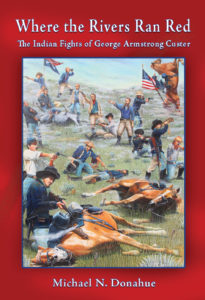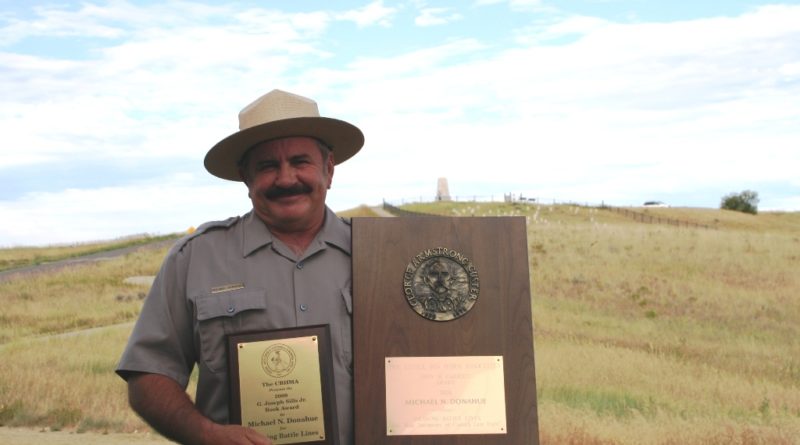Book takes historical and holistic look at Custer
By Catherine Hosman
Michael N. Donahue is an artist, historian, author, the chair of the Temple College Visual Arts Department and an expert on one of the most infamous generals and battles in American history.
 Donahue is a scholar and lifelong student of the Battle of Little Bighorn and George Armstrong Custer, as well as Native American history and culture. He is the longest serving seasonal park ranger at Little Bighorn Battlefield National Monument, which now sits in the middle of the Crow Indian reservation in Montana. This summer marks his 30th year as an historical interpreter at the battlefield.
Donahue is a scholar and lifelong student of the Battle of Little Bighorn and George Armstrong Custer, as well as Native American history and culture. He is the longest serving seasonal park ranger at Little Bighorn Battlefield National Monument, which now sits in the middle of the Crow Indian reservation in Montana. This summer marks his 30th year as an historical interpreter at the battlefield.
Donahue’s second book on Custer’s Last Stand, “Where the Rivers Ran Red: The Indian Fights of George Armstrong Custer” published by San Juan Publishing, takes readers on a roller coaster ride of emotions. The book chronicles the four Indian battles fought by General Custer — from the battle on the Washita River to his final battle at the Little Bighorn. The book is based on archaeology, eyewitness testimony and Donahue’s 45 years of research about Custer.
There are about 3,000 books on the life and battles of Custer, including books about his individual Indian fights, but no one has ever put the four battles in one book in such detail. Donahue visited each of the battle sites he writes about in the book. Each place has its own history, ghosts and perspective. “There has been no book written about his four Indian battles in the 142 years since the last battle,” Donahue said.
“Where the Rivers Ran Red” opens with the story of Clara Blinn and her young son, Willie, who were captured by a Cheyenne raiding party from a wagon train in Eastern Colorado.
On Nov. 27, 1868, Custer and his troops rained down on a quiet Cheyenne village camped along the Washita.
“The Blinns were killed by the Cheyenne as revenge for Custer’s attack there,” Donahue said. “Custer would soon realize that his attack had led to the deaths of Clara and Willie in an adjacent abandoned village along the Washita. It would cause him to reconsider future attacks on native villages.”
This was Custer’s first fight with Native Americans. His next two were with Sitting Bull along the Yellowstone River in 1873, and his final one was at Little Bighorn on June 25-26, 1876, that Donahue documented in his first book, “Drawing Battle Lines: The Map Testimony of Custer’s Last Fight” (Upton and Sons, 2008).
Custer was commissioned to lead one of four battalions of soldiers. Capt. Frederick Benteen and Major Marcus Reno led one each. A fourth battalion led by Capt. Thomas McDougall was a mule pack train carrying supplies and ammunition. Custer entered into battle on the Little Bighorn with a confidence based on his three previous fights against Native Americans.
“Custer loved to fight. He was a commander of men in the Civil War and he knew how to lead others. Leading men was his life’s work,” Donahue said. “At Little Big Horn, things changed. His luck runs out. Benteen was ordered to bring ammunition and come quick. He did neither.”
Donahue said he hopes to de-myth Custer’s bigger-than-life persona as an Indian killer in this book. “There was more to the man than what has been presented in films and movies. He was more of a manipulator. Custer killed more white men than Indians, and Sitting Bull killed more Indians than white people.”
Donahue said the Battle of Little Bighorn was a watermark of Indian Wars. “Just as the confederacy would never rise again after Gettysburg, the Northern Cheyenne and Lakota would never win another battle.” After Custer’s defeat, the U.S. government made it a mission to go after Indians.
“Where the Rivers Ran Red: The Indian Fights of George Armstrong Custer,” is a historical and holistic look at Custer’s Indian battles on the Western frontier. “It’s for the general public. Anyone can relate and understand. It’s written as more of a story,” Donahue said. “My first book is more of a resource book. This book is for the mainstream, for anyone wanting to learn more about Custer and his Indian fights.”
Donahue also wants his book to be educational. He wants his readers to come away with a better understanding of the soldiers and Indians. “I want to present a better understanding of so many stereotyped images,” he said. “I want to humanize them and teach people we can learn something from history, relate it to today’s politics and our treatment of other cultures.”
Donahue said there are three reasons people come to Little Bighorn Battlefield National Monument: the intriguing people who fought there, the mystery of not knowing exactly what happened, and the uniqueness of the battlefield. The site now has markers for Indians, soldiers and individuals who died in the battle. It is also the final resting place for 5,000 veterans from the Indian wars up to Vietnam.
“When I first arrived there I believed I knew quite a bit about the battle — then I realized there was so much to learn. You never learn all of the answers. It’s the mystery that draws the American public to the site. I’ve learned so much from my Crow friends — ways of living, ways of thinking, the different landscape, the history of the people, and their respect for the environment,” Donahue said. “Working as a park ranger is a wonderful way to meet people and share American history with them.”





I’ve been fortunate to have known Donahue since we first met at the battlefield in 1986. A truly gifted, yet humble man. A good person to call friend.
His new book will surprise many, and if read with an open-mind, one will better understand Custer as an individual rather than a myth.